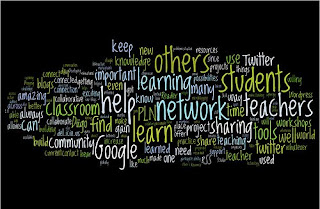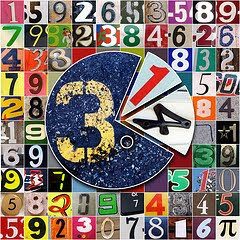New Teacher Tips
"Being a first year teacher can be overwhelming to say the least. There is new curriculum to learn, unfamiliar school policies, classroom management challenges, and new teammates. Technology can help to ease some of these first year growing pains." from Kelly Tenkley, author of the iLearnTechnology Blog
Sunday, August 21, 2011
Thursday, May 26, 2011
Seeking Some Advice?
Now that the 2010-2011 academic year is coming to a close, I started thinking back to my first year as a classroom teacher. Even though my colleagues taught me a lot, sometimes its the experience itself that teaches you the most. Looking back I wondered how differently certain situations could have played out "if only I had known" certain things.
My first year was one of the hardest. I remember wondering what the teachers around me were doing to meet the high demands of the job. Perhaps they had something special in their bag of tricks that I didn't? What method did they have for keeping things simple and less overwhelming? If they had answers, I wanted to hear them! I didn't want "textbook" or cookie cutter advice...I wanted some REAL advice from REAL people in the profession. With that said, I decided to reach out to my professional learning network in hopes they could answer a question for me, "What advice do you wish someone had given you as a first year teacher?" A big thank you to everyone who responded. Check out the SlideRocket presentation below to see the top 10 tips given by teachers or click on the Google form to read the responses.
My first year was one of the hardest. I remember wondering what the teachers around me were doing to meet the high demands of the job. Perhaps they had something special in their bag of tricks that I didn't? What method did they have for keeping things simple and less overwhelming? If they had answers, I wanted to hear them! I didn't want "textbook" or cookie cutter advice...I wanted some REAL advice from REAL people in the profession. With that said, I decided to reach out to my professional learning network in hopes they could answer a question for me, "What advice do you wish someone had given you as a first year teacher?" A big thank you to everyone who responded. Check out the SlideRocket presentation below to see the top 10 tips given by teachers or click on the Google form to read the responses.
Tuesday, May 10, 2011
Prezi, Prezi, Prezi ...
Have you seen a presentation done using Prezi?
Have you thought about trying to create using Prezi?
According to Steve Johnson in Digital Tools for Teaching:
Prezi is a radically new way to thinking about traditional presentations. It allows you to do the normal things you expect, like adding text, images, video, etc,. but it executes them in exciting formats. Think of your presentation as a giant, three-dimensional map of information separated into scattered sections. Prezi allows you to create these sections of information at different angles and "zooms" from section to section.
In other words, instead of clicking from slide to slide like a traditional presentation, in Prezi you'll zoom from section to section as you present content. The effect is a sharp-looking presentation that will make your audience stop and take notice.
I know that for me one of the best ways to learn what is possible with a new creation tool is to look at things created with that tool. That way you will get some ideas of what is possible, maybe some things you want to copy, and possibly some thing you want to avoid.
Prezi provides an excellent way to do that with various prezis found on the Explore Tab on the Prezi site. Also on the Explore Tab, you can find reusable prezis. You can make a copy of the prezi and then change the information to make it your own. On the Learn Tab, you can find simple instructions to view as well as "cheat sheets" for you to use.
Here is a nice Prezi that I found on how Prezi can be used to teach skills:
Thoughts on using Prezi as a teaching tool on Prezi
As a word of advice ... be careful how much zooming and twisting/turning you do in your presentation ...
You don't want to make your audience motion sick ... you want them to learn!
Monday, May 9, 2011
A Question A Day
So we have now had a new multi-touch mobile SMARTBoard with the extreme short throw projector in our office for a little over a month now and I have to weigh in on it.
First off the multi-touch capability for me has to be one of the best features of the board. The ability to have two people working on the board at the same time is a great feature. As well the ability to size images similarly to what an iPad/iPod, SMARTTable or Microsoft Surface can do with the multi-point drag feature. Most of the rest of the board features are the same as they were before but with a couple of tweaks here and there for upgrades and add-ons.
So what have we been doing with it for the past month? We have been asking questions. I know you may be thinking, why or what? We wanted to see how people reacted to the board as they were coming into and through the office. The questions are more of a prompt than anything else in that we want people to touch and interact with the board. Some people have come in and asked us what it is, while others know what it is and just keep going. We have had some takers with the questions that we have been asking. Things like, what is your favorite cereal, to thought provoking ones about your favorite quotes. The main thing is that people are touching the board and asking questions about it.
So as a teacher, I have to ask you how do you use your interactive white board (IWB)? Whether it is a Promethean ActiveBoard or a SMARTBoard. Do you just look at it in the room? Is it just a fixture on the wall, or stand? Or is it a tool that you use within your classroom? The best thing that you can do with your IWB is use it, and if you do not understand something just ask. I am pretty sure that there is someone in your building that can answer or is willing to help you to get the answers to your questions. Remember that you have an on-site technology facilitator as well as a District Instructional Technologist that are here to help you to better understand the tool so that you can make it an effective, integrated and productive part of your instructional day.
First off the multi-touch capability for me has to be one of the best features of the board. The ability to have two people working on the board at the same time is a great feature. As well the ability to size images similarly to what an iPad/iPod, SMARTTable or Microsoft Surface can do with the multi-point drag feature. Most of the rest of the board features are the same as they were before but with a couple of tweaks here and there for upgrades and add-ons.
So what have we been doing with it for the past month? We have been asking questions. I know you may be thinking, why or what? We wanted to see how people reacted to the board as they were coming into and through the office. The questions are more of a prompt than anything else in that we want people to touch and interact with the board. Some people have come in and asked us what it is, while others know what it is and just keep going. We have had some takers with the questions that we have been asking. Things like, what is your favorite cereal, to thought provoking ones about your favorite quotes. The main thing is that people are touching the board and asking questions about it.
So as a teacher, I have to ask you how do you use your interactive white board (IWB)? Whether it is a Promethean ActiveBoard or a SMARTBoard. Do you just look at it in the room? Is it just a fixture on the wall, or stand? Or is it a tool that you use within your classroom? The best thing that you can do with your IWB is use it, and if you do not understand something just ask. I am pretty sure that there is someone in your building that can answer or is willing to help you to get the answers to your questions. Remember that you have an on-site technology facilitator as well as a District Instructional Technologist that are here to help you to better understand the tool so that you can make it an effective, integrated and productive part of your instructional day.
Friday, May 6, 2011
How I used twitter to build my PLN ...

I started by reading the tweets from the few people I followed, but most of them lived in the same area as me and I wanted to see what was possible on a bigger level. So I started looking at the people writing the tweets that were getting ReTweeted (RT). I again looked at profiles and recent tweets to see if I felt they might add value to my "Twitter time." Most of those people fit my "requirements" for being followed. If I follow someone on Twitter for a while and then decide I am not finding their tweets very useful (especially if they have a lot of 4square), then I just unfollow them (this is my personal opinion).
I also find more people to follow by sometimes participating in things like edchat. If someone asks a question that I respond to, I also look at the other people who have responded to find more people to possibly follow. The same goes with people who use certain hashtags (that is when you "tag" you tweet with a number sign and certain letters ex. #wsfcs). I also don't necessarily follow everyone who follows me.
Now, at first I did not think I had a PLN since that was, in my mind, for people who had been on twitter longer and connected with more people. I have come to understand that for me, anyone who contributes to my learning is a part of my Personal Learning Network, whether online or not, but Twitter has allowed me to learn about so many things from so many different people.
I am thankful for all that learning and for all those people! :)
image from Sue Waters and found at http://www.flickr.com/photos/suewaters/2673475018/in/photostream/

Each week Steven W. Anderson (@web20classroom on twitter) and Melissa Edwards (@mwedwards on twitter) do a podcast where they talk about things related to instructional technology. They talk about tools, ideas, resources, and little bit of everything!
Click here to hear what they are talking about this week. (You can also listen to previous podcasts too ... they are all in one location).
If you have an idea for a topic they should discuss on the podcast, just let them know! If you would like to be a guest on the podcast, they would love to know that too!
Math resources ....
 I was just looking around on twitter when a few tweets that were sharing great resources caught my attention. I noticed they shared the same hashtag ... #4thchat.
I was just looking around on twitter when a few tweets that were sharing great resources caught my attention. I noticed they shared the same hashtag ... #4thchat.I started looking more and quickly realized why those resources captured my attention ... I had just found 4th grade teachers sharing resources and ideas! I taught 4th grade for years and tend to gravitate towards those resources.
There is a wiki set up to collect the resources shared in these chats. So far there are categories for Brain Breaks, Grouping Strategies, 21st Century Tools, and Writing Strategies. The topic that night was Math Instruction.
Here are some of the resources that caught my attention:
- a Symbaloo full of K-5 Math Links
- TenMarks .. free fun and interactive math practice and learning environment for 3rd grade and higher
- Math by Design was created for middle school students taking Algebra I and II to enhance their understanding of geometry and measurement objectives.
- Math and Literature Idea Bank from math cats
- Magic of Math list of books
- Stewart 4th Grade Online Resource Wiki - Math Page
- Recommended book to read: What's Math Got To Do With It? by Jo Boaler
Subscribe to:
Comments (Atom)